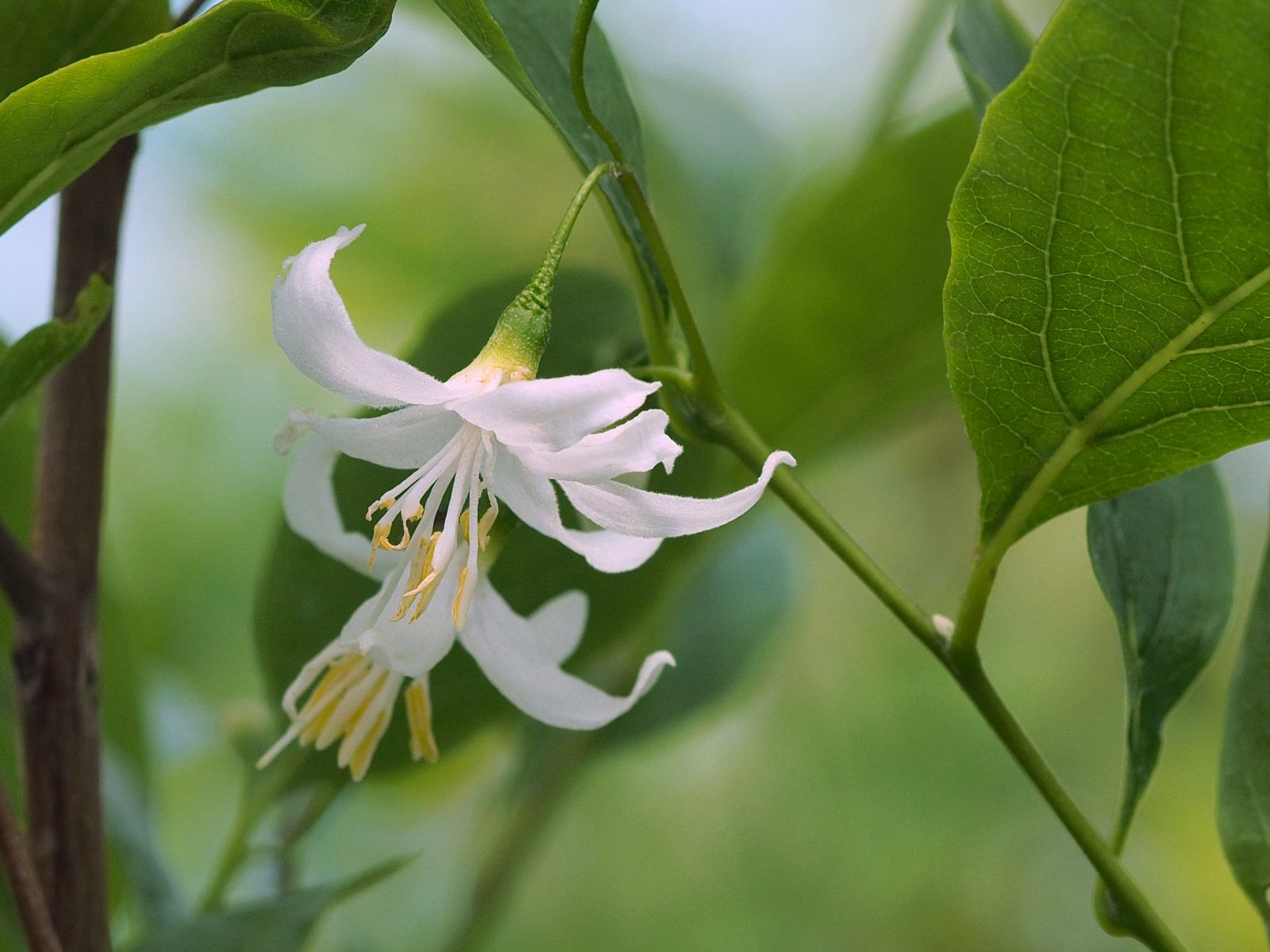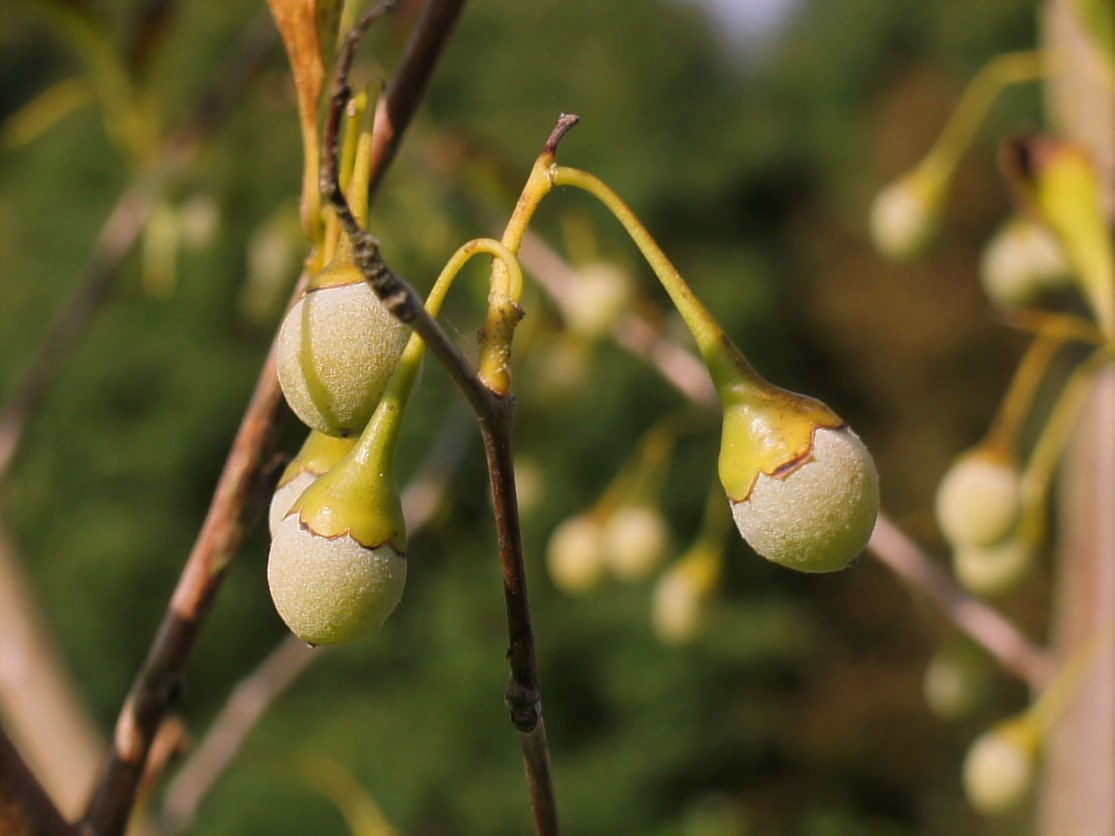Styrax americanus
Sponsor
Kindly sponsored by
Arabella Lennox-Boyd
Credits
Alan Elliott (2017)
Recommended citation
Elliott, A. (2017), 'Styrax americanus' from the website Trees and Shrubs Online (treesandshrubsonline.
Genus
Common Names
- American Storax
- American Snowbell
- Mock-Orange
Synonyms
- Styrax americana [orth. var.] Lam.
- Styrax laevigata Ait.
- Styrax americanus var. pulverulentus (Michx.) Rehder
- Styrax pulverulentus Michx.
Other taxa in genus
- Styrax calvescens
- Styrax confusus
- Styrax dasyanthus
- Styrax faberi
- Styrax formosanus
- Styrax grandifolius
- Styrax hemsleyanus
- Styrax hookeri
- Styrax japonicus
- Styrax limprichtii
- Styrax obassia
- Styrax odoratissimus
- Styrax officinalis
- Styrax platanifolius
- Styrax redivivus
- Styrax serrulatus
- Styrax shiraianus
- Styrax suberifolius
- Styrax tonkinensis
- Styrax wilsonii
- Styrax wuyuanensis
Shrubs or trees to 5 m. Branchlets sparsely to densely grey stellate pubescent, becoming brown, glabrous. Leaves papery, 1.2–10 × 0.6–5.7 cm, elliptic or broadly elliptic to obovate or nearly ovate, glabrous or sparsely to densely grey stellate pubescent, five to eight secondary veins on each side of the mid-rib, serrate, serrulate, denticulate or entire, apex acute to acuminate; petiole 0.2–0.6 mm. Inflorescence axillary (pseudo-terminal), raceme, 2–5-flowered or solitary flower, to 3.5 cm long; Pedicels 0.4–1.0(–1.4) cm. Flowers 1.1–1.6 cm long; calyx five-toothed, corolla tube 1.5–3 mm, lobes 5, 0.7–1.4 cm long, elliptic to narrowly elliptic; filaments distinct beyond adnation to corolla, glabrous. Fruit globose, 0.7–0.9 cm long, gray stellate-pubescent, apex apiculate. (Fritsch 2009).
Distribution United States Alabama, Arkansas, Florida, Georgia, Illinois, Indiana, Kentucky, Louisiana, Mississippi, Montana., North Carolina, Ohio, Oklahoma, South Carolina, Tennessee, Texas, Virginia.
Habitat Wooded floodplains, swamps, boggy slopes, hammocks, usually in sandy or peaty soils; altitude 0–300 m.
USDA Hardiness Zone 4b-8a
RHS Hardiness Rating H4
Conservation status Not evaluated (NE)
Taxonomic note Densely pubescent forms, common in the southernmost part of the range, have sometimes been recognised as a distinct species, or at infrapsecific rank within S. americanus (e.g. Gonsoulin 1974) but the Flora of North America account considers these differences ‘taxonomically inconsequential’ (Fritsch 2009).
Native to the southeastern United States this species was first introduced to the UK as early as 1765, most likely by John Bartram, the father of American Botany. Bartram travelled widely in the United States and sent seeds, specimens and natural history curiosities back to his patrons in England via the English merchant Peter Collinson, in what would become known as ‘Bartram’s Boxes’. Bartram is credited with seeding much of Europe with the early introductions of American plant species. It forms a slender-stemmed, ‘wispy’ shrub with significant charm and garden value (at least in the eastern United States), though it does not colour in autumn Dirr (2009).
In the wild S. americanus is partly sympatric with S. grandifolius, although they are separated by their ecological niches with the latter occurring at higher altitues. According to the Flora of North America, hybridisation between the two is not known in the wild. (Fritsch 2009).
Although not currently (2017) growing at RBG Kew, in earlier editions Bean stated this species had long been cultivated at there, but grew slowly as it appeared to be marginally hardy (Bean 1981b). This species appears to be more suited to the southwest of the British Isles where it grows as a small shrub, flowering in early to mid-July at the Caerhays Estate. Given the right sheltered conditions it is possible to cultivate this specimen elsewhere in the UK as this species is found in the collections at RHS Wisley, Sir Harold Hillier Gardens and Benmore Botanic Garden, Argyll. The National Botanic Gardens, Glasnevin, in Ireland has a truly remarkable example of this species, at over 7 m this specimen is much taller than other examples in cultivation.
S. americanus is more widely cultivated and more widely available in the horticultural trade in the US than in Europe. It appears in a number of botanic garden collections, for example the United States Botanic Garden, Longwood Gardens, The Scott Arboretum of Swarthmore College, Denver Botanic Gardens and New York Botanic Garden. Although not formally treated for the IUCN redlist, this species is considered threatened in Illinois and presumed extinct in Ohio.


